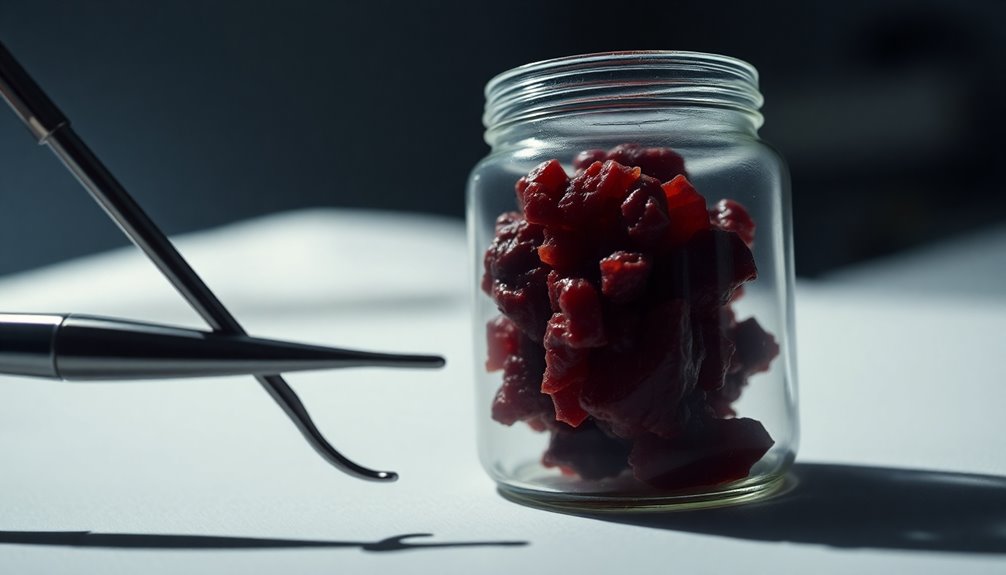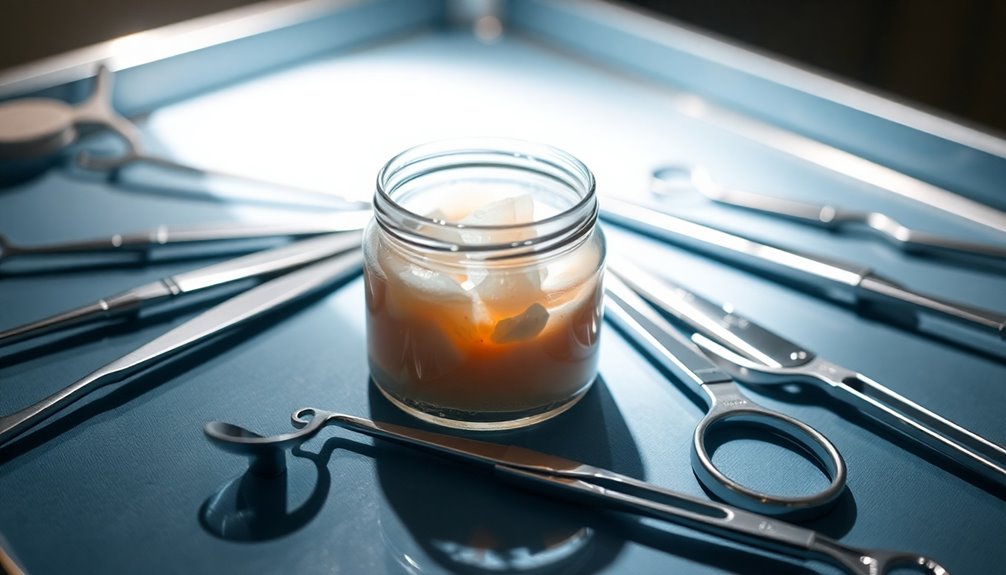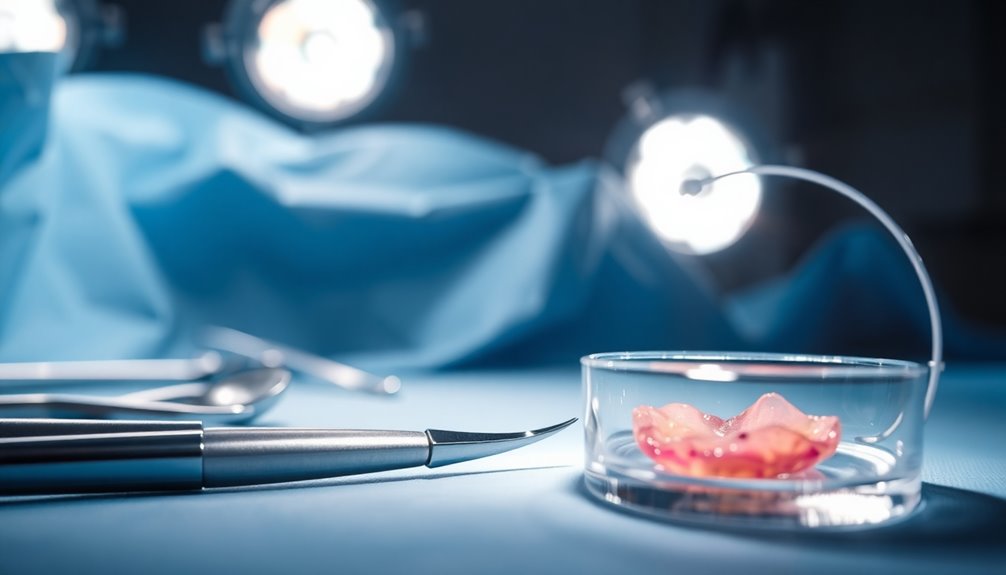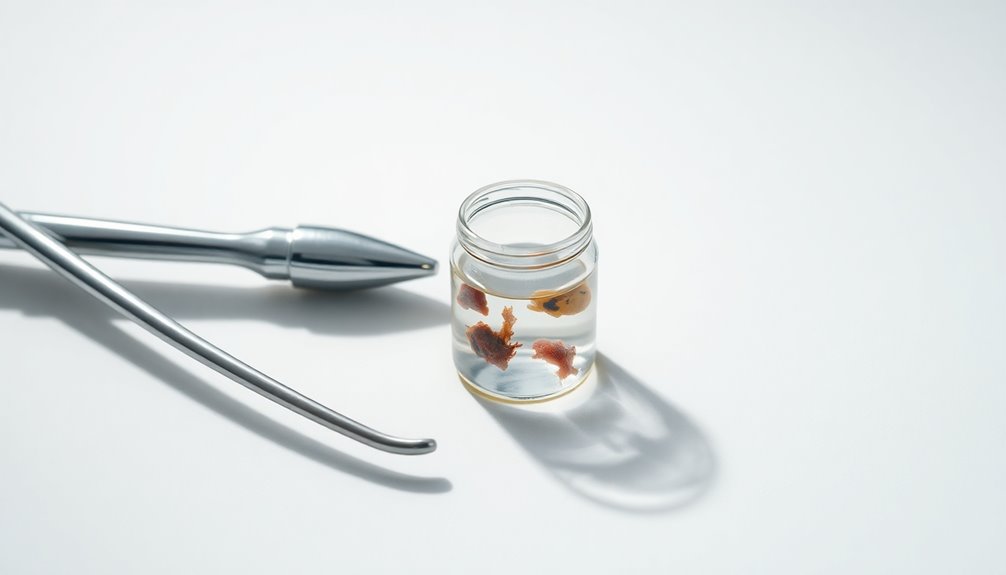If you've had a curettage procedure, watch out for retained tissue, which affects 1-5% of patients. It can cause heavy bleeding, pelvic pain, and fever, leading to serious complications like infections or uterine perforation. Incomplete removal often occurs due to surgical technique issues or dense tissue. Diagnosis involves blood tests and ultrasounds, while treatment may require medications or repeat procedures. Stay informed and find out what you can do to prevent this potentially alarming issue.
Key Takeaways
- Retained tissue after D&C occurs in 1-5% of cases, leading to complications if not addressed promptly.
- Symptoms include heavy bleeding, pelvic pain, fever, and hormonal imbalances, necessitating medical evaluation.
- Diagnosis involves blood tests, ultrasounds, and hysteroscopy for direct examination of the uterus.
- Treatment options include medications like misoprostol or repeat D&C for effective tissue removal.
- Emotional impacts of retained tissue can be significant, requiring counseling and support for recovery.
Understanding Retained Tissue After Curettage

When you undergo curettage (D&C), it's essential to understand that retained tissue can sometimes linger in your uterus afterward.
This leftover placental or uterine tissue can lead to complications, such as heavy bleeding or infection. The incidence of retained tissue after D&C ranges from 1-5%, depending on factors like the completeness of the procedure and your individual circumstances.
Symptoms to watch for include persistent heavy bleeding, abdominal pain, or fever—signs that require prompt medical attention.
Your healthcare provider may use imaging studies, like ultrasound, to diagnose retained tissue. If necessary, a follow-up D&C might be needed to remove any leftover material, ensuring proper management and minimizing risks such as postpartum hemorrhage.
Causes of Incomplete Tissue Removal

When you consider the causes of incomplete tissue removal during curettage, surgical technique limitations often come into play.
Factors like uterine abnormalities and inadequate visualization can make it tough to access all areas effectively.
Understanding these issues is key to improving outcomes and minimizing retained tissue.
Surgical Technique Limitations
Despite the careful planning that goes into a dilation and curettage (D&C) procedure, various surgical technique limitations can lead to incomplete tissue removal.
Improper surgical technique, such as insufficient dilation of the cervix or using inadequate instruments, can result in retained products of conception. Dense or adherent tissue, like that seen in placenta accreta, complicates complete removal.
Additionally, anatomical abnormalities, such as fibroids, may obstruct access to certain areas, making it challenging to evacuate all tissue. Operator experience greatly influences outcomes; less experienced practitioners might inadvertently leave behind retained tissue.
To mitigate complications, post-procedure imaging like ultrasound is often recommended to confirm complete removal and guarantee patient safety.
Uterine Abnormalities Factors
Uterine abnormalities greatly impact the effectiveness of curettage procedures, often leading to incomplete tissue removal. Conditions like fibroids or polyps can obstruct access to the uterine lining, increasing the risk of retained products of conception (RPOC). A history of uterine surgery may also create scarring that complicates the process.
| Uterine Abnormality | Impact on Curettage |
|---|---|
| Irregularly shaped uterus | Hinders complete tissue removal |
| Fibroids/Polyps | Obstructs access to uterine lining |
| Placenta accreta | Higher chance of retained tissue |
Women with nulliparity may have anatomical variations that elevate these risks. It's essential for your medical team to evaluate these factors to enhance the success of the procedure.
Symptoms of Retained Tissue

Retained tissue after a dilation and curettage (D&C) procedure can lead to several concerning symptoms that you should be aware of. The most common symptom is heavy or irregular vaginal bleeding.
Retained tissue after a D&C can cause heavy bleeding and irregular periods, signaling a need for medical attention.
You might also experience pelvic pain, fever, or notice an enlarged, tender uterus, which can indicate retained tissue. If you miss menstrual periods, it could signal a hormonal imbalance due to leftover material in your uterus.
Additionally, signs of infection, like persistent fever or foul-smelling discharge, may arise if retained tissue leads to complications.
It's essential to seek prompt medical evaluation if you notice any of these symptoms, as they can lead to serious health conditions, including postpartum hemorrhage.
Don't ignore these warning signs!
Risks and Complications Associated With Retained Tissue

When you have retained tissue after a D&C, you face several risks that can impact your health.
Heavy bleeding, potential infections, and even uterine perforation are serious concerns that require immediate attention.
It's essential to recognize these risks early on to prevent complications.
Potential Infection Risks
Infections can arise from tissue left behind after a dilation and curettage (D&C) procedure, as the presence of foreign material can disrupt your body's natural healing process.
If retained tissue, particularly retained products of conception (RPOC), isn't addressed promptly, it can lead to serious complications. You might notice symptoms like:
- Fever that leaves you feeling drained
- Foul-smelling vaginal discharge that raises alarms
- Severe pelvic pain that disrupts your daily life
- Increased bleeding that seems concerning
- A sense of urgency for medical evaluation
Studies show that 1-5% of women may experience infections like endometritis after a D&C.
Timely follow-up is essential to prevent severe infection or sepsis from retained tissue. Don't ignore the signs.
Heavy Bleeding Concerns
Following a D&C, heavy bleeding can be a significant concern, especially if tissue is left behind. Retained placenta can lead to postpartum hemorrhage (PPH) if not addressed quickly, with approximately 3% of women experiencing this issue.
If you notice increased vaginal bleeding, high fever, or severe pelvic pain, it's essential to seek immediate medical evaluation. Delaying treatment can result in severe complications like anemia and infection, which pose serious health risks.
Timely intervention is important to prevent life-threatening situations and long-term reproductive health issues. Remember, proper monitoring after a D&C can help identify retained tissue early, ensuring you receive the necessary care to avoid the dangers of heavy bleeding and PPH.
Uterine Perforation Possibility
Although uterine perforation is rare, it's a serious risk that can arise during a dilation and curettage (D&C) procedure, particularly when addressing retained tissue.
You should be aware of the following potential complications:
- Severe abdominal pain that won't go away
- Heavy vaginal bleeding, especially after delivery
- Signs of internal bleeding, like dizziness
- Increased risk of infection due to retained tissue
- Potential need for additional procedures, like hysteroscopy
If you experience any of these symptoms, seek immediate medical attention.
Prompt diagnosis and treatment of uterine perforation are critical to prevent severe complications, which may include damage to surrounding organs or, in extreme cases, a hysterectomy.
Always discuss these risks with your healthcare provider before the procedure.
Diagnosis of Retained Tissue Post-Curettage

When you undergo curettage, it's imperative to monitor for symptoms that might indicate retained tissue, such as heavy or irregular vaginal bleeding, pelvic pain, and fever.
Monitoring for symptoms like heavy bleeding, pelvic pain, and fever is crucial after curettage to detect retained tissue.
The diagnosis of retained tissue often begins with these clinical signs. Blood tests, including the HCG test, help assess hormone levels that can suggest retained products of conception (RPOC).
Imaging techniques like transvaginal ultrasound and color Doppler ultrasound are used to visualize the uterine cavity and identify any remaining tissue. Hysteroscopy allows for a direct examination of the uterine lining, vital for spotting retained tissue that other methods might miss.
Timely diagnosis is essential, as untreated retained tissue can lead to complications like infection and postpartum hemorrhage.
Treatment Options for Retained Tissue

When dealing with retained tissue after a D&C, you have several treatment options.
Medications like misoprostol can help induce contractions to expel the tissue naturally, but if that doesn't work, a repeat D&C might be necessary.
It's important to stay alert for any concerning symptoms and communicate them with your healthcare provider.
Medications for Tissue Expulsion
Medications play an essential role in managing retained products of conception (RPOC) after a miscarriage or abortion. One commonly used medication is misoprostol, which helps induce uterine contractions to facilitate the expulsion of retained tissue.
This non-invasive option allows for outpatient care, minimizing the need for surgical interventions unless complications arise.
Here are some potential experiences during treatment:
- Cramping that feels intense but manageable
- Occasional nausea that passes quickly
- Diarrhea that's typically mild and controllable
- A sense of relief as the body responds
- The reassurance of close monitoring by your healthcare provider
Always consult your healthcare provider for a tailored treatment plan based on your specific circumstances and response to medications.
Surgical Intervention Options
Surgical intervention options for retained tissue are vital when medications alone aren't effective. Dilation and curettage (D&C) is often the first-line treatment, allowing for both diagnosis and the removal of leftover placental or uterine tissue.
If a D&C doesn't fully address the issue, hysteroscopy may be employed to visualize and directly remove the retained tissue from the uterine cavity. These procedures are typically performed under anesthesia to guarantee your comfort.
After surgical intervention, be aware of potential complications like heavy bleeding, infection, or uterine perforation, which occur in 1-3% of D&C cases.
It's important to schedule a follow-up appointment to assess the intervention's effectiveness and discuss any further treatment if retained tissue remains.
Importance of Follow-Up Care

Follow-up care is essential after a dilation and curettage (D&C) procedure because it allows for careful monitoring of your recovery and helps catch any complications early.
Scheduling that follow-up appointment within a few weeks is critical.
Consider these important aspects of your follow-up care:
- Discussing results with your healthcare providers
- Evaluating your healing progress
- Monitoring for symptoms like heavy bleeding or fever
- Understanding next steps for future pregnancies
- Documenting findings for future reference
Emotional Impact of Retained Tissue

Experiencing retained tissue after a dilation and curettage (D&C) can trigger a range of intense emotions, including grief and anxiety. Many individuals feel trauma from the experience, especially if it follows a miscarriage or abortion. The emotional impact can linger long after physical symptoms have resolved, underscoring the need for strong support systems and mental health care.
| Emotion | Description | Support Strategies |
|---|---|---|
| Grief | A sense of loss and mourning | Counseling, support groups |
| Anxiety | Worry about health and future | Mindfulness, relaxation techniques |
| Trauma | Feelings of PTSD-like symptoms | Therapy, open communication |
| Emotional Distress | Ongoing feelings of sadness | Peer support, mental health resources |
Talking openly with healthcare providers is essential for healing.
Preventing Retained Tissue in Future Procedures

To effectively prevent retained tissue during future curettage procedures, careful planning and execution are essential.
You can take several proactive steps to minimize risks and prevent complications:
- Conduct thorough preoperative assessments to identify risk factors.
- Use advanced imaging techniques, like transvaginal ultrasound, to spot abnormalities.
- Employ meticulous surgical techniques to guarantee all visible tissue is removed.
- Administer medications, such as oxytocin, post-procedure to encourage uterine contractions.
- Schedule follow-up appointments to monitor your recovery and catch any signs of remaining tissue.
Seeking Medical Attention: When to Call Your Doctor

How can you tell if something's not right after a curettage procedure?
If you experience heavy or persistent vaginal bleeding, it's vital to contact your doctor, as this may indicate retained tissue or other complications.
Additionally, if you develop a high fever over 100.4°F (38°C) or chills, don't wait—seek medical attention immediately, as these could signal an infection.
Severe pelvic pain that worsens over time is another red flag, suggesting potential complications that need evaluation.
Be sure to report any unusual symptoms like faintness, dizziness, or rapid heartbeat, which may indicate significant blood loss or anemia.
Always consult your healthcare provider about any concerns to guarantee proper healing and address possible issues promptly.
Frequently Asked Questions
How Do You Know if You Have Retained Tissue After D&C?
If you suspect you have retained tissue after a D&C, watch for heavy or prolonged vaginal bleeding, severe pelvic pain, or fever.
These symptoms might indicate complications. To assess your hormone levels, your doctor may order an HCG blood test; elevated levels could suggest retained tissue.
A transvaginal ultrasound or hysteroscopy can help visualize your uterus and confirm any issues.
What Is the Most Common Complication of a Curettage?
The most common complication of a curettage is the retention of tissue, occurring in about 1-5% of cases.
If you undergo this procedure, be aware that retained products of conception can lead to symptoms like irregular bleeding and pelvic pain.
While serious complications like uterine perforation and infections are rare, it's vital you monitor your recovery closely and attend follow-up appointments to guarantee everything is healing properly.
What Happens if You Have Retained Tissue After an Abortion?
If you've had an abortion, you might worry about what happens if you retain tissue. This can lead to heavy bleeding, pelvic pain, or even fever, which can be alarming.
You'll likely need imaging tests to check for retained products of conception. If diagnosed, treatment options include medication to induce contractions or a surgical procedure like D&C.
It's essential to address this promptly to avoid complications and guarantee a healthy future pregnancy.
What Happens if RPOC Is Not Removed?
If retained products of conception (RPOC) aren't removed, you could face serious complications.
You might experience heavy bleeding, infection, and persistent abdominal pain. Your uterus may not contract properly, raising the risk of postpartum hemorrhage, which can be life-threatening.
Additionally, untreated RPOC could lead to scar tissue formation in your uterus, resulting in infertility.
It's crucial to seek immediate medical attention to avoid these risks and protect your reproductive health.
Conclusion
To summarize, it's essential to stay informed about the risks of retained tissue after curettage. Remember, "an ounce of prevention is worth a pound of cure." By understanding the symptoms and seeking timely medical advice, you can safeguard your health and well-being. Don't hesitate to follow up with your doctor and voice any concerns. Being proactive can make all the difference, ensuring a smoother recovery and preventing complications down the line.









